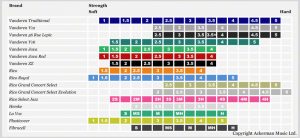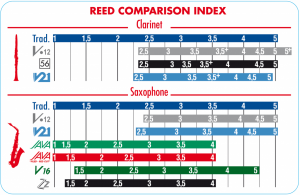If you or your child plays an instrument that uses a reed, there are several questions that come up. When you’re just getting started, you need to know how long each reed lasts and more advanced students will wonder when to move up in reed strength or even how to know what brand of reed is best.
How long does each reed last?
The biggest danger to a reed is chipping or splitting it. This is common when the player is just getting started and becoming familiar with assembling the instrument and is usually an issue that goes away fairly quickly.
After that hurdle is cleared, there’s the issue of how often each reed should last. If you’re playing every day, you can get a couple of good weeks out of the reed. The salts from your saliva will prevent the reed from drying out as completely as it once did and inhibit the vibration of the reed. That is the science-y side of it. Functionally, the sound won’t be as pure as it once was and it will begin to sound dull and flat. 
To make sure you always have reeds ready to go, professionals (both in performing and education) strongly recommend rotating through your reeds by means of a Reed Guard or some other reed case designed to prolong the life of each reed so you use a different reed every day and simultaneously break in four at a time. You never want to break in a new reed at a concert! That would be like taking new tennis shoes to a marathon — bad idea!
When should I change reed strength?
Reed strength isn’t synonymous with playing ability. The industry standard for just getting started is a 2.5 or 2 ½. Not all teachers recommend their students starting on that strength, but it is the most common. There isn’t a set time to change the reed strength, so don’t feel pressured to do so just because others around you are changing. As you learn to play, you are building muscles around your mouth known as the embouchure. There can be a point where those muscles get too strong for the current reed to keep up and that’s usually a time to go up half of a strength (i.e. 2.5 to 3).
Signs of the reed being too soft for you:
-Producing a buzz-y sound
-Blowing the reed shut
-Overall tone quality declines
It is similar to lifting weights at the gym. When you first start out, 10 pound dumbbells might be your workout limit. As you get stronger, eventually 10 pounds is just too easy, so you grab 15 pound dumbbells. It all depends on you and no one else. Private instructors and even classroom teachers occasionally will point out to a student that the strength of their reed needs to be increased by hearing them play. You’ll get the hang of it!
What is the difference in brands?
There are two very popular brands (Rico and Vandoren) with several others. All of it is about preference. Vandoren is a nicer cut of cane, but Rico is cheaper. Because of the nicer cut, Vandoren also tends to feel a bit stiffer than the equivalent Rico reed. Something else you will notice is that Vandoren has all of these different styles (V12, V21, ZZ, Java, etc.) and it can be very confusing on what is best to use.
Here are a couple of charts that compare different reeds so you can get an idea of the consistency of strength from brand to brand. The second compares the clarinet Vandoren reeds to each other and the alto sax Vandoren reeds to each other. The second chart can give you information that is more focused on your particular instrument.
If you’re wondering why it seems so skewed, the specialty reeds are designed with the thought of professional mouthpieces or even a particular style of playing. Upgraded mouthpieces have a wider tip opening (among other changes) where you need a softer reed in order to get the desired sound and to not tire out your embouchure too quickly.
Summary
Ultimately, once you learn to take care of your reeds properly, strength and style are dependent on you as a player. Exploring mouthpiece upgrades will almost certainly change the reed you play and you might find that there is a certain combination that really produces the sound you’re looking for.
Feel free to come down to the store and test out some different mouthpieces and see if one works better for you. There are endless combinations to be made of mouthpieces with reeds so your possibilities are endless!





